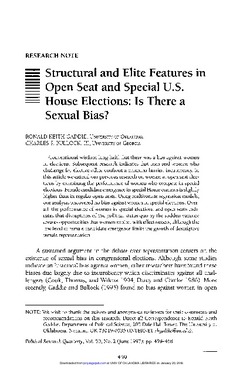| dc.contributor.author | Ronald Keith Gaddie | |
| dc.contributor.author | Charles S. Bullock | |
| dc.date.accessioned | 2016-01-14T19:53:28Z | |
| dc.date.accessioned | 2016-03-30T15:36:32Z | |
| dc.date.available | 2016-01-14T19:53:28Z | |
| dc.date.available | 2016-03-30T15:36:32Z | |
| dc.date.issued | 1997-06-01 | |
| dc.identifier.citation | Gaddie, R. K., & Bullock, C. S. (1997). Structural and Elite Features in Open Seat and Special U.S. House Elections: Is There a Sexual Bias? Political Research Quarterly, 50(2), 459-468. doi: 10.1177/106591299705000210 | en_US |
| dc.identifier.uri | https://hdl.handle.net/11244/25270 | |
| dc.description.abstract | Conventional wisdom long held that there was a bias against women in elections. Subsequent research indicates that men and women who challenge for elective office confront a common barrier: incumbency. In this article we extend our previous research on women in open seat elec tions by examining the performance of women who compete in special elections. Female candidate emergence in special House contests is slightly higher than in regular open seats. Using multivariate regression models, our analysis uncovered no bias against women in special elections. Over all, the performance of women in special elections and open seats indi cates that disruptions of the political status quo by the sudden vacancy creates opportunities that women exploit with effectiveness, although the low level of female candidate emergence limits the growth of descriptive female representation. | en_US |
| dc.language.iso | en_US | en_US |
| dc.publisher | Political Research Quarterly | |
| dc.title | Structural and Elite Features in Open Seat and Special U.S. House Elections: Is There a Sexual Bias? | en_US |
| dc.type | Research Article | en_US |
| dc.description.peerreview | Yes | en_US |
| dc.description.peerreviewnotes | https://us.sagepub.com/en-us/nam/manuscript-submission-guidelines | en_US |
| dc.identifier.doi | 10.1177/106591299705000210 | en_US |
| dc.rights.requestable | false | en_US |
